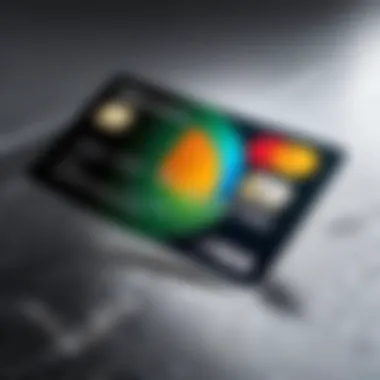Explore Alternative Cell Phone Insurance Options


Intro
In today’s world, mobile phones have transformed from mere communication devices to essential life tools. The importance of protecting these gadgets cannot be overstated, but navigating the landscape of cell phone insurance can be as daunting as finding a needle in a haystack. Not all insurance options are created equal, and traditional policies often come with their own set of limitations and high premiums. However, there are alternative avenues that are just as valuable—if not more so.
This guide will shine a spotlight on various alternatives, from self-insurance to third-party warranties, while also highlighting the perks and pitfalls of each. It’s high time that consumers arm themselves with knowledge, so you can make informed decisions tailored to your preferences and wallet.
Product Overview
When we dive into alternative cell phone insurance, it’s crucial to first understands the various products available in the market. Unlike typical insurance policies, these alternatives can cater to diverse needs and can be structured in many ways.
Self-Insurance
Self-insurance involves setting aside a specific amount of money to cover potential repair or replacement costs. You’re basically acting as your own insurer, which means no monthly premiums but also no safety net unless you've saved appropriately.
Third-Party Warranties
These warranties come from companies other than the manufacturer or carrier. Brands like SquareTrade or Asurion offer plans that often cover accidental damage, mechanical failures, and other mishaps that might mean trouble for your device. The coverage terms can vary, but overall, they often provide more protection than standard insurance plans.
Credit Card Benefits
Some credit cards offer built-in protection for items purchased using their card. For example, cards from companies such as Visa or Mastercard might provide extended warranties or even insurance against theft and damage for a limited time period. This perk often flies under the radar, but can be a hidden gem worth exploring.
Performance and User Experience
Choosing the right alternative cell phone insurance option depends largely on how well it performance aligns with your personal needs and everyday experiences.
Speed
The responsiveness of claims processing can be a game changer. Many third-party warranty providers boast faster claim handling than traditional insurers. This means less waiting and more peace of mind.
User Interface
Navigating the claims process online or through an app should be simple. Many modern warranty companies understand the importance of a user-friendly design, offering straightforward online platforms to file claims without hassles.
Customization Options
Depending on the alternative option chosen, there can be more flexibility. Self-insurance allows you to decide how much to set aside, while certain warranties can let you add on coverage for specific scenarios.
Comparison with Similar Products
When weighing these options, it's worthwhile to analyze how they stack up against standard insurance policies.
Key Differences
Alternatives often feature customizable plans, fewer excluded scenarios, and potentially lower overall costs compared to traditional insurance. Conventional policies usually come with copays, deductibles and often a complex claims process.
Understanding Cell Phone Insurance
When someone pulls out their shiny smartphone, it often feels like an extension of themselves. But owning a device comes with the hefty price tag, not just for the phone but for ongoing protection of it too. Cell phone insurance stands as a safety net against unexpected mishaps, providing peace of mind in a world where accidents lurk around every corner.
Cell phone insurance isn't merely a luxury; it’s a necessity for many in today’s fast-paced digital landscape. With the average cost of smartphones rising, individuals find themselves weighing the pros and cons of insuring such a crucial part of their daily lives. Beyond the initial purchase price, repairs and replacements can drain wallets faster than one can say "pixels and chips." Furthermore, insurance helps mitigate risks associated with theft, water damage, or even hardware malfunctions.
The Traditional Model
In broad strokes, traditional cell phone insurance typically operates through carriers and well-established insurance companies. Consumers pay monthly premiums, ranging from a few dollars to a significant chunk of change, depending on the plan. When faced with a loss, policyholders file a claim, leading to repairs or replacements often based on the provider's terms and conditions.
However, this model often comes with lengthy waits and the stress of hidden fees. For example, certain plans might not fully cover accidental damage or may impose a deductible that feels like emptying one’s pockets after an unfortunate incident. Providers also can impose their own wait times, leaving users without their precious devices for longer than they’d like.
Limitations of Conventional Insurance
Despite the advantages, conventional insurance isn't without its pitfalls.
- High Monthly Premiums: Paying a premium feels like a safety blanket until your wallet proves otherwise. Some plans might squeeze a generous amount each month, leading to a heavy burden over time.
- Deductibles: When you finally have to utilize the insurance, the deductible can bite hard. Some deductibles are surprisingly high, making the insurance feel less like a cushion and more like a trip to the dentist.
- Exclusions: Many policies come with pages of exclusions you may never comprehend fully until a claim arises. Water damage? It may not be covered. Dropping your phone? Often, it’s not in the fine print.
- Claim Limits: Some policies limit how often one can claim for a device, and after that threshold is met, your insurance might not be there to help.
Understanding these limitations can save you from unexpected surprises and financial strain when you need assistance the most.
In essence, knowing how cell phone insurance works and its limitations leads buyers to make informed choices on whether the coverage they are purchasing serves their needs. It’s not just about protecting a device; it’s about securing a considerable investment and avoiding pitfalls that may lead to regret.
Types of Alternative Coverage


When it comes to protecting your mobile device, relying solely on traditional insurance policies can feel like putting all your eggs in one basket. People are now turning towards alternative coverage options, which can often provide better adaptability to individual needs. This section delves into the various forms of alternative coverage available today, highlighting unique elements, benefits, and considerations to keep in mind as you navigate this path toward safeguarding your tech investments.
Self-Insurance Strategies
Self-insurance is like wearing a seatbelt on a roller coaster—it's all about taking precaution where you can. This strategy is often viewed as a way for users to save money in the long run by establishing a savings fund specifically meant for unexpected failures or accidents. It requires discipline and planning, as individuals need to set aside a certain amount each month.
Investing in self-insurance means acknowledging the risk and actively preparing for it. You might start by assessing your device's current value. Let’s say you own a high-end Samsung Galaxy S22. That little beauty probably cost you a pretty penny, so it makes sense to set aside a portion of your monthly budget to cover possible repair or replacement costs.
Here’s how to navigate self-insurance:
- Determine Your Monthly Setup: Decide how much you can afford to set aside. A good rule might be about 1-2% of the phone’s value per month.
- Create a Fund: Open a dedicated savings account. This way, you won't accidentally dip into the funds for non-emergencies.
- Know Your Costs: Research common repair prices to gauge how much to save.
Self-insurance can make sense financially, especially if you're generally careful with your device. On the flip side, if accidents happen more often than you’d like to admit, it might lead to significant financial stress.
Third-Party Warranties
If setting aside money doesn’t quite float your boat, third-party warranties might be your saving grace. These warranties can offer repair services or replacements for a fraction of the cost typically associated with a traditional policy.
Think about it—let's say you bought a warranty from SquareTrade for your Pixel 7. This option is typically less expensive than insurance, and it covers some common pitfalls such as accidental damage. Usually, these services have fewer hoops to jump through compared to mainstream insurance providers. Here are a few things to keep in mind:
- Coverage Details: Not all plans are created equal. Read the fine print! Some warranties might cover accidental damage but not mechanical failure.
- Claim Process: Understand how claims are filed. Some companies allow you to handle everything online, while others may require you to mail in your device.
- Duration of Coverage: Compare the warranty length and see if it matches your timeline with the device. A two-year warranty on a flagship model is common, but some people hold onto their phones longer.
The value here is in knowing what you’re buying. Warranties can fill in gaps that self-insurance might leave, especially for those with a tendency to experience mishaps.
Credit Card Protections
Many people don’t realize that their credit card could be a safety net, especially if you’re paying for your smartphone using it. Some cards offer coverage against theft or accidental damage, potentially turning your once-simple transaction into substantial protection.
For example, if you used your Chase Sapphire Preferred Card to snag an iPhone 14, you might just find that you have damage protection included. Here’s what to focus on:
- Check Your Card’s Benefits: Call your issuer or check their website to understand what’s covered. Each card has different rules.
- Filing Claims: Find out the claims process. It’s usually straightforward but can vary significantly.
- Time Limits: Keep an eye on how quickly you need to file a claim post-incident.
Using credit card protections can be a smart way to manage costs, but you need to be aware of any limitations. It’s always prudent to familiarize yourself with these options before relying on them solely.
"Educating oneself on the nuances of coverage can transform the chaos of accidents into manageable situations."
Each of these alternative coverage options has its unique appeal based on individual usage habits and financial preferences. With informed decisions, you can navigate the myriad of options available, ensuring your mobile device is adequately protected. The choice ultimately rests on your lifestyle and how you perceive risk when it comes to your prized technology.
Evaluating Costs vs. Benefits
Evaluating costs versus benefits is vital when considering alternatives to traditional cell phone insurance. Making an informed decision often requires weighing the monetary factors against the potential risks of device damage or loss. The key elements to look at include monthly premiums, deductibles, and the overall cost of ownership. This section will provide a thorough understanding of what to consider, helping users to get the most bang for their buck while ensuring their devices are protected.
Analyzing Monthly Premiums
When diving into the landscape of mobile insurance, monthly premiums can be a the top of the list, and it's important to approach them with a discerning eye. Typically, these premiums represent a recurring expense and might vary depending on factors like device value, coverage limits, and the provider.
For instance, comparing a third-party warranty like SquareTrade against self-insurance may highlight stark differences in what you’re shelled out each month. A warranty might have a premium of $9 or $15, while on the other hand, self-insuring might mean stashing away $20 monthly in a savings account dedicated to unexpected repairs or replacements. By doing the math, you can identify which option is more feasible or economical in the long run.
"Often, the costs seem trivial until the reality of device damage strikes."
It’s worth keeping in mind that while a lower premium may seem enticing, it can come with limitations, like coverage exclusions that might catch you off guard when you least expect it. Always ensure to compare the fine print of what's promised for the monthly fee.
Understanding Deductibles
Deductibles often feel like the underbelly of insurance, lurking beneath the surface until you are hit with a claim. In essence, a deductible is the amount you must pay out-of-pocket before your coverage kicks in. Different insurance policies feature different deductible structures—some may feel hefty, whereas others are surprisingly manageable.
Consider a scenario where you indemnify a high-end smartphone worth $1,200. If your deductible under a traditional plan is $250, you’ll be responsible for this cost if your phone meets an unfortunate fate. In contrast, if you chose a warranty plan or are self-insuring, you could be facing a much lower or no deductible at all when repairs are needed.
Consequently, understanding how these deductibles impact your overall payment obligations helps you to evaluate insurance options clearly. If you’re risk-averse, selecting options with lower deductibles may save you headaches down the line, even if the monthly cost is somewhat steeper.
Calculating Total Cost of Ownership
Calculating the total cost of ownership (TCO) goes beyond just premiums and deductibles. It provides a broader view, factoring in expenses like repair costs, replacement fees, and any potential loss of data that could arise with device failure. TCO can vary significantly based on usage patterns and how liable the user is to causing wear and tear.
For example,
- Monthly Premiums: Let’s say you opt for a warranty with a premium of $15. After two years, that's a total of $360.
- Deductibles: If you end up needing to make a claim and the deductible is $100, that adds to your cost.
- Repair or Replacement Costs: If you need to repair a cracked screen or replace a lost phone,
- Repair: $200
- Replacement: $500


The total adds up and if calculated correctly, provides clarity on expected financial impacts.
In the end, a careful analysis of the costs versus the benefits allows you to make informed choices tailored to your personal risk tolerance and device usage. Investing time upfront can ensure that you don't end up pouring money down the drain on inadequate or excessive coverage.
Remember, the choices you make today could either save you a pretty penny or leave you scrambling for cash during a crisis. So take your time and evaluate all angles thoroughly.
Key Considerations for Choosing Coverage
Choosing the right coverage for your cell phone is not just about what looks good on paper, it’s a matter of personal needs and financial realities. When evaluating alternative insurance options, you want to be sure that you’re not throwing your money down a rabbit hole. Every choice should be based on a thorough understanding of your priorities, potential risks, and the actual value of your device to you.
Assessing Your Device Value
This is like taking a hard look in the mirror—only this time, it’s about your phone. Understand that the worth of your device goes beyond its original price tag. Several facets can determine its true value, such as:
- Brand and Model: High-end models like the Samsung Galaxy Z Fold 4 have a different depreciation curve than a mid-range option.
- Condition: Is it pristine, or does it have scratches? A device in excellent shape has a market value that’s higher.
- Usage: Are you using it primarily for communication, or are there significant business applications? The more you rely on it, the more value it has.
Aligning your coverage with the worth you place on your device can save you money or provide better protection.
Usage Patterns and Risks
Every user has unique habits with their mobile devices, and understanding these can help tailor your insurance choices. Ask yourself:
- Daily Use: A phone that travels with you everywhere is more likely to face hazards.
- Activity Level: If you’re an outdoor enthusiast or constantly on the go, higher risk factors are at play.
- Historical Performance: If you've experiences significant accidents or losses in the past, consider higher coverage.
There’s a saying that goes, “an ounce of prevention is worth a pound of cure,” and it rings especially true when it comes to protecting your devices. Assessing your risk will guide you towards more appropriate coverage.
Evaluating the Fine Print
When it comes down to it, the devil is in the details. The fine print often contains critical information that can alter your coverage experience. Here are a few pointers:
- Exclusions: Be sure to know what’s not covered. You might be surprised to find that certain damages are excluded.
- Claim Process: Understand how claims are filed. A lengthy process can be a headache when you need timely assistance.
- Recovery Limits: Some policies have caps on reimbursement, which may not align with your device's real value.
As you navigate through these details, make notes and ask questions if something isn’t clear. > "Reading between the lines can save you from a fall."
The Role of Technology in Alternative Insurance Solutions
In today’s world, technology has become the backbone of our daily lives, and this extends to the need for protecting our mobile devices. The role of technology in alternative insurance solutions cannot be overstated; it redefines how consumers safeguard their devices and enhances the ways they can recover from unfortunate incidents.
Embracing technological innovations can lead to better decision-making; consumers are now equipped with tools that not only help them keep track of their devices, but also facilitate repairs when needed. The integration of apps and online services is crucial for minimizing risk and maximizing the life of a phone, which lowers the chances of needing extensive insurance coverage in the first place.
Technology aids in creating smarter, more tailored solutions that fit the unique lifestyles of users. Whether utilizing GPS for tracking, or leveraging online marketplaces for repairs, there’s a myriad of options that make traditional insurance look cumbersome in comparison.
"Technology doesn’t just change the game; it rewrites the rules."
Smartphone Tracking & Recovery
The advent of smartphone tracking technologies plays a vital role in safeguarding against loss or theft. Most modern smartphones come pre-installed with built-in tracking services. For instance, Find My Device for Android allows users to locate their phones in real-time. This feature not only helps find lost devices but also enables users to remotely lock or erase sensitive data to guard against unauthorized access.
The effectiveness of these services goes beyond the basic tracking functionality. Here are key points to consider:
- Real-time tracking: Locate your phone instantly using GPS technology.
- Remote actions: Lock your device or wipe personal info from anywhere, ensuring peace of mind.
- Notification alerts: Set up alerts if your device moves beyond a certain range.
Furthermore, third-party apps such as Prey Anti Theft provide even more control and customizable tracking features, making it easier for users to recover lost devices. This makes the need for traditional insurance policies less pressing, as users can rely on tracking to deter thieves and recover their belongings quickly.
Repair Apps and Services
When it comes to damage, technology also lends a hand. Numerous repair apps and services have emerged, providing consumers with the ability to manage repairs smoothly and often at a lower cost than traditional insurance deductibles. Popular options like uBreakiFix or ItFix let users find certified technicians nearby who can repair cracked screens, water damage, and other common issues without going through lengthy insurance claims.
The significant advantages include:
- Convenience: Schedule repairs at your convenience, sometimes same-day service.
- Cost Efficiency: Bypass high insurance deductibles with straightforward pricing.
- Transparency: Get detailed quotes and diagnostics to know exactly what you're paying for, fostering trust.
Ultimately, integrating these repair solutions into your mobile strategy allows for immediate response without the hassle of navigating traditional insurance routes. Technology empowers users to take control, making informed choices that align with their needs and preferences.
Emerging Trends in Mobile Insurance
In the fast-evolving digital landscape, mobile insurance is no exception to the wave of transformation. Staying abreast of emerging trends in mobile insurance is crucial, particularly as technology continues to reshape the way consumers protect their devices. The shift from traditional policies towards more dynamic, on-demand solutions has made it necessary for consumers to reassess their insurance strategies in light of their lifestyle and usage patterns.
On-Demand Insurance Models


On-demand insurance models have been carving out their niche in the world of mobile protection. This approach allows individuals to purchase insurance coverage just when they need it, rather than committing to long-term policies. For instance, someone might only need coverage when they’re traveling or participating in a risky engagement. This flexibility can lead to significant savings and less waste.
Moreover, these models often come with user-friendly apps that enable policyholders to quickly activate and deactivate their coverage as per their needs. Imagine getting a notification from your insurance app just as you're boarding a flight, allowing you to seamlessly activate your policy for the duration of your trip.
The benefits of on-demand models are clear:
- Cost-effective: Pay only when needed, avoiding monthly fees for coverage not in use.
- Simplified access: Instant activation through mobile platforms.
- Tailored protection: Customize coverage based on specific situations.
Despite these advantages, there are considerations to keep in mind. While on-demand insurance offers convenience, some consumers might find the necessity to react to situations rather than proactively managing their coverage a bit daunting. It is essential to thoroughly evaluate the terms and conditions, understanding when you are covered and the extent of that coverage.
Blockchain and Insurance Transparency
The incorporation of blockchain technology in mobile insurance is paving the way for unmatched transparency and trustworthiness in the industry. This technology, known for its secure and decentralized nature, offers a potential game-changer in how claims are processed and how policies are managed.
Using blockchain, every policy detail, claim, and transaction can be securely stored and accessed, ensuring both parties can verify the information easily. In a world where data breaches are becoming commonplace, the appeal of having an immutable record is glaring.
Benefits of implementing blockchain in mobile insurance include:
- Increased trust: Both parties can collaborate without doubt; fraud attempts are significantly reduced.
- Speed: Claims can be processed faster since all data is verified and accessible.
- Lower Costs: Transaction fees and administrative costs can diminish.
However, like any technology, there are hurdles to clear. For one, many consumers may still be unfamiliar or hesitant about blockchain. Education and awareness campaigns are imperative to help users understand the benefits and applications.
In summary, as we progress into a new era of mobile insurance, recognizing these emerging trends can empower consumers to make more informed choices about their device protection strategies. Being aware of on-demand insurance models allows flexibility tailored to lifestyle changes, while embracing blockchain can enhance trust and reliability in what has traditionally been a murky process.
Case Studies: Real-World Applications
Examining case studies in the realm of alternative cell phone insurance options provides a valuable lens through which we can evaluate how different strategies manifest in real-world scenarios. These cases highlight not only the successes but also the challenges that come with navigating the often murky waters of device protection. Ultimately, they serve as a robust educational tool for those contemplating which coverage option might best suit their needs.
When it comes to protection for your cellphone, having examples of how others have benefited from self-insurance or third-party warranties adds significant weight to our understanding. By analyzing specific incidents, we gather insight into practical applications, unforeseen pitfalls, and, perhaps most importantly, user satisfaction levels.
"Real-world examples can illuminate aspects of insurance plans that theoretical readings often miss. They help bridge the gaps between what we've been taught and what actually happens in everyday situations."
Successful Self-Insurance Examples
Consider John, who opted for self-insurance after purchasing his latest Android device. He allocated $30 a month into a savings account. This gave him a cushion for repairs or replacements should issues arise. After two years, he faced a cracked screen from a recent mishap. Instead of dealing with an insurance entity, he used his own funds to cover the repair costs, which amounted to $200. After adding it all up, John realized he had saved money overall by avoiding a monthly premium and deductibles associated with traditional insurance.
Another notable example is Sarah, a tech enthusiast known for her frequent device upgrades. She keeps her old smartphones as backup devices. By self-insuring through personal savings and reusing her gadgets, she typically sidesteps the need for formal insurance. If her primary phone fails, she always has a backup, hence lessening her overall device risk.
These stories reinforce the notion that self-insurance can be a viable option if the individual is disciplined enough to save systematically and understand the associated risks.
Analyzing Third-Party Warranty Experiences
Now let's look at Lisa, who decided to explore a third-party warranty offered by SquareTrade. When she purchased her iPhone, she found their discounts appealing. For a premium of about $8 a month, SquareTrade promised comprehensive coverage, including damages and theft.
A few months later, Lisa accidentally dropped her phone in a pool. She filed a claim and was surprised at how smoothly the process unfolded. Within a week, she had a refurbished phone at her doorstep. While her initial experience was positive, she later discovered that not everything was covered under the warranty. For instance, the warranty did not apply if she lost the phone without any physical damages. It caused her to reflect on the coverage and how it could have been better explained.
There’s also Mike, who went with Asurion for his Samsung Galaxy. His experience was markedly different; after submitting a claim, he was met with delays and communication issues. Mike's warranty told him to expect a new phone in a week, but it took nearly three weeks. While he ultimately received his device, the stress added during that waiting period left him feeling frustrated.
This section highlights the contrasting experiences between third-party warranties. Engaging with such case studies equips consumers with the knowledge needed to approach warranties thoughtfully, especially concerning the fine print and real-world implications. Understanding these user experiences can mitigate disappointment and enhance decision-making.
In summary, case studies provide rich narratives illustrating how various cell phone insurance options play out in real life. They not only enlighten readers about the potential advantages and pitfalls but also empower them to make informed decisions aligned with their personal circumstances.
Future of Cell Phone Insurance
The landscape of cell phone insurance is evolving, much like the devices themselves. With technological advancements and changing consumer needs, understanding the future of this coverage is crucial for individuals seeking to protect their devices effectively. As traditional insurance models often offer limited solutions, alternative options can empower users to choose plans that fit their unique lifestyle and preferences.
Towards Customizable Coverage
The move towards customizable coverage is perhaps one of the most significant trends in the future of cell phone insurance. Consumers today demand flexibility to tailor policies to their specific needs. Gone are the days when individuals had to settle for one-size-fits-all plans.
This shift towards customization involves not just choosing coverage types, but also adjusting premiums and deductibles based on personal usage patterns.
- User-Controlled Adjustments: Imagine an application where users can adjust their coverage based on how careful they are with their phones. For instance, someone who takes extra precautions might want a lower premium with fewer options, while a working professional might opt for a comprehensive plan.
- Coverage for Specific Mishaps: Consumers could opt to insure only against certain incidents—like cracked screens or theft—without paying for protection against issues they consider unlikely.
Offering personalized policies that reflect individual risk assessments can make cell phone insurance much more relevant and effective.
Consumer Awareness and Advocacy
With the rapid changes in the mobile insurance space, there's a growing need for consumer awareness and advocacy. As options expand, so does the potential for confusion. People must be informed not only about the different types of coverage but also about their rights as consumers. This awareness will help them make more educated decisions.
- Educating the Public: Communities should share resources, such as guides and comparisons of various insurance options, to help individuals navigate choices.
- Creating Advocacy Groups: Nonprofits or forums on platforms like Reddit can rally around consumer interests, pushing for clearer policies and better coverage standards.
The role of consumer advocacy is vital as it ensures that companies remain accountable and consumers receive fair treatment.
Remember: Knowledge is power. By staying informed about new trends and options in cell phone insurance, consumers can protect their investments better and engage in discussions that influence the industry at large.







